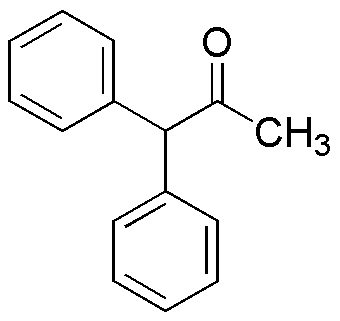1,1-Diphenylacetone is widely utilized in research focused on:
- Organic Synthesis: It serves as an important intermediate in the synthesis of various organic compounds, enabling chemists to create complex molecules efficiently.
- Pharmaceutical Development: This compound is used in the production of certain pharmaceuticals, contributing to the formulation of drugs with specific therapeutic effects.
- Photochemical Applications: It acts as a photosensitizer in photochemical reactions, which is valuable in developing new materials and processes in the chemical industry.
- Polymer Chemistry: 1,1-Diphenylacetone is utilized in the production of polymers, enhancing material properties such as strength and thermal stability.
- Research in Material Science: It is employed in studies related to the development of new materials, particularly in the fields of coatings and adhesives, due to its unique chemical properties.
General Information
Properties
Safety and Regulations
Applications
1,1-Diphenylacetone is widely utilized in research focused on:
- Organic Synthesis: It serves as an important intermediate in the synthesis of various organic compounds, enabling chemists to create complex molecules efficiently.
- Pharmaceutical Development: This compound is used in the production of certain pharmaceuticals, contributing to the formulation of drugs with specific therapeutic effects.
- Photochemical Applications: It acts as a photosensitizer in photochemical reactions, which is valuable in developing new materials and processes in the chemical industry.
- Polymer Chemistry: 1,1-Diphenylacetone is utilized in the production of polymers, enhancing material properties such as strength and thermal stability.
- Research in Material Science: It is employed in studies related to the development of new materials, particularly in the fields of coatings and adhesives, due to its unique chemical properties.
Documents
Safety Data Sheets (SDS)
The SDS provides comprehensive safety information on handling, storage, and disposal of the product.
Product Specification (PS)
The PS provides a comprehensive breakdown of the product’s properties, including chemical composition, physical state, purity, and storage requirements. It also details acceptable quality ranges and the product's intended applications.
Certificates of Analysis (COA)
Search for Certificates of Analysis (COA) by entering the products Lot Number. Lot and Batch Numbers can be found on a product’s label following the words ‘Lot’ or ‘Batch’.
*Catalog Number
*Lot Number
Certificates Of Origin (COO)
This COO confirms the country where the product was manufactured, and also details the materials and components used in it and whether it is derived from natural, synthetic, or other specific sources. This certificate may be required for customs, trade, and regulatory compliance.
*Catalog Number
*Lot Number
Safety Data Sheets (SDS)
The SDS provides comprehensive safety information on handling, storage, and disposal of the product.
DownloadProduct Specification (PS)
The PS provides a comprehensive breakdown of the product’s properties, including chemical composition, physical state, purity, and storage requirements. It also details acceptable quality ranges and the product's intended applications.
DownloadCertificates of Analysis (COA)
Search for Certificates of Analysis (COA) by entering the products Lot Number. Lot and Batch Numbers can be found on a product’s label following the words ‘Lot’ or ‘Batch’.
*Catalog Number
*Lot Number
Certificates Of Origin (COO)
This COO confirms the country where the product was manufactured, and also details the materials and components used in it and whether it is derived from natural, synthetic, or other specific sources. This certificate may be required for customs, trade, and regulatory compliance.


